|
AUGUST 2021
|
|
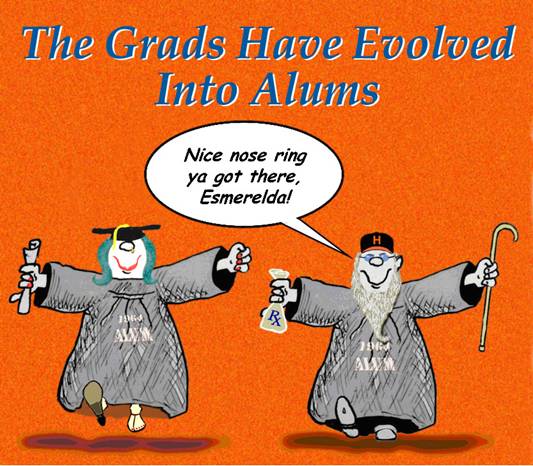
|
|
extrapolated
from a drawing by David Lance in the 1964 Comet Yearbook
|
|

|
July's
AH
looked at childhood as experienced by the earliest Baby Boomers
- essentially, those who were part of the Class of 1964.
It began with the latter 1940s, and more or less left us
in the world that surrounded us when we were nine years old.
This month we continue on through June 1964.
|
|
An
Arbitrary Look Back at Our World, 1946-1964
|
|
PART
II: The mid-1950s Through 1964
|
|
***
|
Applied
Science
It was the 1950s, and science
permeated life. We got
vaccinated for polio in school. The
papers, radio, and TV constantly used words like nuclear.
There were A-bombs and H-bombs, nuclear warheads, and nuclear
fallout. Controlled fission
was going to generate clean energy for our homes.
It already was powering submarines, which soon would be able to
launch missiles armed with thermonuclear warheads.
Republic and Grumman were nearby, developing supersonic aircraft to play
critical roles in the next, presumably nuclear, war.
Once in a while sonic booms rattled our windows to remind us of
that.
The Arms
Race begat a Space Race.
America
knew a lot about building missiles that could carry explosives across
the globe. Now it was trying
to lever that knowledge to make rockets that carried people straight up.
The transition proved far from easy.
During our final year in elementary school, Sputniks
won the first two heats of the race.
In
Florida
, Vanguard rockets (designed
explicitly to launch
America
's first satellite) repeatedly failed.
Even after those Sputniks
had reached orbit, a Vanguard
attained an unimpressive liftoff of 3'11."
Its satellite was thrown clear of the wreckage; it bounced and
rolled like a pink Spaldeen, valiantly emitting radio signals that told
of its epic flight.
Americans were told that the Vanguard's
abominable record was due to its being "too advanced."
They got the message: our engineers did not yet know enough about
what they were attempting. The
country was feeling uneasy.
|

|

|
|
Dec 1957: Satellite TV-3 is thrown clear
of another Vanguard explosion
National Air and
Space
Museum
photo
|
published
in Vogue, 1 Nov 1955
oldcarandtruckpictures.com
|
Not every scientific development was met
with instant failure or success. Tappan's
Radarange - the first
commercial microwave oven - had been sold since 1946, but largely was
ignored by the public. A
decade later, Chrysler introduced a push-button automatic transmission.
Drivers found it hard to use for parking, when their eyes quickly
moved around, looking everywhere except at the small button cluster on
the dashboard.
The "Bottle Opener" Years
|

|
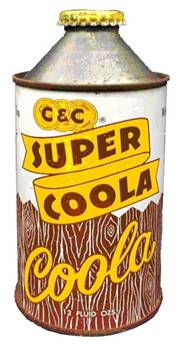
|
|
cork
seal in bottom of bottle cap
timepassagesnostalgia.com
|
Cantrell
and Cochrane, Super Coola can
worthpoint.com
|
Bottle
openers were simple but essential tools, needed to open cork-lined
crimped metal caps. Bottle
caps were so ingrained in our lives that when someone finally decided to
put soft drinks in cans, we still needed bottle openers!
Whatever
you drank, and whether it came in cans or bottles, the jingles and
advertising campaigns were with us whenever we listened to radio or
watched television - that is, all the time.
Am I the only one whose family included females who discussed the
merits of the annual Miss
Rheingold contestants? Evidently,
sales of Rheingold tripled because of the contest.
For the year of her reign, a winner would appear in TV and
magazine ads, as she sailed, bowled, vacationed, hunted, rode on
horseback, sunned at the seashore, and even was taught how to bunt by
Casey Stengel. But she was
never seen drinking beer!
|
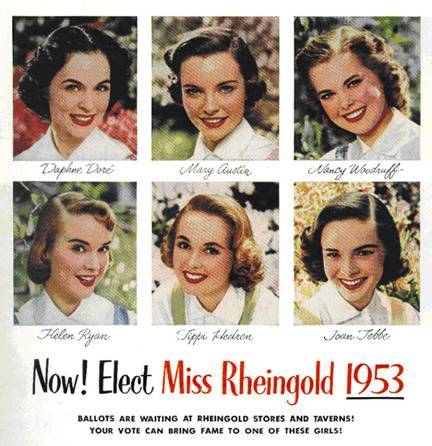
|
|
1953
Miss Rheingold Finalists
Tippi
Hedren did not win, but she did go on to star in 'The
Birds.'
Later, she gave birth to Melanie Griffith, and still later
she became the grandmother of Dakota Johnson.
amazon.com
|
|
***
|
Farewell to Coal
|
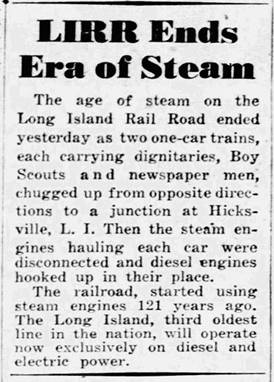
|
|
Daily
News, October 9, 1955
|
The
railroad ended its long dependence on coal in 1955.
In October of that year, a ceremony at
Hicksville
commemorated the change. Although
the reasons behind it were economic, towns like
Hicksville
received other tangible benefits. Travelers
on the LIRR now could open
windows on hot days without fear of being covered in ash and hot cinders
(something which I learned in childhood was no fun at all).
There was less smoke in the air, and coal dust stopped
accumulating on buildings near the tracks.
With no steam locomotives needing to take on water, the old
railroad water tank that blighted
Jerusalem Avenue
was demolished.
Separating the Good From the Bad
|

|
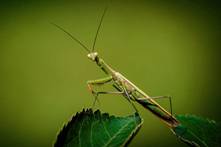
|

|
|
Japanese
Beetle
goodhousekeeping.com
|
Praying
Mantis
islandssounder.com
|
Eastern
Tent Caterpillar
Wikimedia
Commons
|
In
school, we were taught that some life forms are better than others.
Praying mantises, for
example, were sacrosanct because they helped control pests.
I cannot recall ever being told just which pests they killed, but
pests were abundant in
Hicksville
when we were children. Every
year, Japanese beetles came from... well, wherever they always came
from, to feast on peonies, roses, or anything else they found in our
gardens. Children collected
them in jars; my father bought insecticidal sprays; nothing helped very
much. Every so many years,
tent caterpillars appeared en
masse. Well-organized,
they expanded their birth tents into multi-chambered dwellings.
If one ventured out and found a tree with edible leaves, it laid
a scent trail back to the tent. Thereafter,
hundreds of its siblings would follow the trail and denude the tree of
its leaves.
|
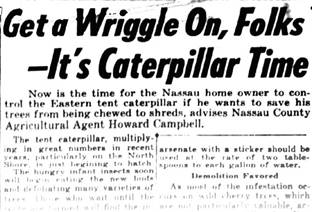
|
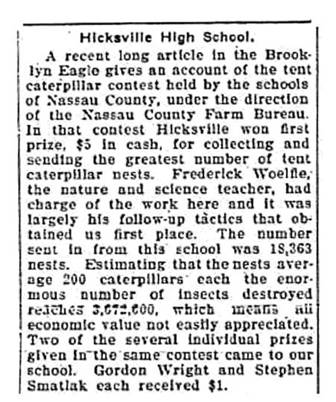
|
|
Daily
News, May 5, 1957
|
Huntington
Long-Islander, June 16, 1916
|
1957
was a boon year for the Eastern tent caterpillar.
One could not ride a bicycle near any overgrown lot without
hearing them pop and squish green liquid out from under the tires.
The official response that year was to spray plenty of DDT
everywhere. Forty-one years
earlier, a communal rather than a chemical solution had worked better:
children collected nests in a competition; all the nests collected were
destroyed.
Hurricanes
My
first
Hicksville
September was in 1954, and it was dramatic.
Hurricane Carol knocked
out telephone service and power for 200,000 LILCO
customers, including most of
Hicksville
. Winds tore shingles and
antennas from houses; rain found new ways to leak into homes.
We read by candlelight, as we had been told Abe Lincoln had done.
A record tidal surge of 14.4 feet flooded the coast.
With aircraft all across the east seeking shelter, Mitchel
Field offered use of its hangar space, after first evacuating the
bombers stationed there to inland USAF
bases.
No one had been ready, largely because the day before, Carol had been downgraded to a gale, and forecasts called only for
rain and occasional gusts of wind. Oops.
Ten days later, when Hurricane Edna
struck, people were better prepared.
Ahead of time, LILCO
conferred with contractors at the
Old Country Road
offices, planning which of them would be dispatched to repair fallen
power lines in different parts of the
Island
.
This time, workers at La Guardia
built a temporary dike to keep out surging sea water:
|

|
|
New
York
Daily News, September 11, 1954
|
Although
Edna did not strike
Long Island
as squarely as Carol had, it
deposited more rain in 24 hours than Greater New York had received in
such a period in more than 50 years.
Before our power died (it soon would be restored), we watched WPIX
broadcast storm scenes live, a first for the
New York
area. The next day, much of
our class time was spent talking about having once again "roughed
it" at home with no power.
Who's Afraid of the Big Bad World?
As
we were nearing our final years of elementary school, the world at large
came into sharper focus because of a recession.
Car sales plummeted by more than 30%, unemployment rose, and (to
everyone's surprise) consumer prices simultaneously increased.
Many of our parents felt uneasy.
As some lost their jobs, the rest worried: "What if prices keep
going up and I lose my job, too?"
|

|
|
1958
Edsel Corsair coupe
The
Edsel became the unintended symbol of the 1957-1958 recession
pinterest.com
|
The recession did not last long, but it was the most severe post-war
recession until the 1970s. Its
lasting casualties would be mourned in
Detroit
, as Hudson, Nash, Packard, DeSoto,
and Edsel were doomed.
All but the last enjoyed customer loyalty to the end, but they no
longer had enough customers to be profitable.
Smaller cars, led by Volkswagen, had gained lasting footholds in the
U.S.
Davy Crockett and Mickey
Mouse Club played their parts in our childhood, but so did "take
cover" drills. One day,
while crouching under my desk (i.e., to dodge hypothetical flying shards
of window glass caused by shock waves from distant nuclear blasts), I
heard a fellow student observe, "Of course, we'd all die from
radiation anyway."
The Korean War - oops, Conflict - ceased before we learned much
about it. I don't think we
were taught much about the war at
Lee Avenue
, but I read an overview in a comic book in the barber shop at Allied.
Obviously, it had been published to drum up popular support for
the UN effort. Incidentally,
while checking facts as I wrote this, I learned that when Ted Williams
was activated for his second war, and flew fighters over
Korea
as a Marine, he was chosen to fly alongside someone whose name was later
in the news a great deal.
|

|
|
John
Glenn and Ted Williams, his wingman in
Korea
military.com
|
In
addition to
Korea
, there still were the Cold War, combat in
Suez
and in
Algeria
, and guerilla fighting in
Budapest
; moreover, the
U.S.
had begun advising / training South Vietnamese troops.
When we visited UN headquarters on school trips, it seemed too
tranquil a place to belong to the world we heard about in the news.
Freshman
Disorientation
Junior High was crowded, noisy, and bewildering.
You could do an indoor lap around the split-level square doughnut
of a building, and accidentally finish on the wrong floor.
In 7th grade, my homeroom teacher's
efforts to teach us study skills were puzzling.
He exhorted us to study "how to study," so that we'd learn
how to study. Study Hall
didn't help. That was a
place to doodle and daydream, to watch the leaves turn color, and on a
bad day to count the spit balls on the ceiling.
For some, it was a convenient place to copy other people's
homework instead of bothering to study at all.
|

|
|
So smooth and creamy on the outside;
so nutty on the inside
photo by Anthony R. Wencer
|
Each day of the week had its own rut,
and finding our way to our next class became automatic.
By 9th grade, we had benefited from our interactions with some
excellent teachers, and with some who were less than excellent.
The chaos of being one of 3,600 students - more than in any
other single school building in the State - would leave many of us
with low opinions of school administrators.
Charms
to Soothe the Savage Breast*
*Shakespeare
never did say 'to soothe the savage beast.'
Thanks to radio, Dick Clark, and 45s,
we had music. Inventing the
transistor had won a Nobel Prize, but someone's discovering how to
mass-produce it cheaply was what benefited us.
Portable radios became feasible.
The music we heard felt as young as we
were. Listening to it, we
forged a bond with the performers, and with each other.
We didn't worry much about the songwriters and music publishers
who kept the flow of new hits going.
Again and again, new songs rose like the sun and brightened our
days. Fan magazines posed
ridiculous questions: Is Frankie
Avalon sexier than Paul Anka? Is
Connie Francis' heart really broken?
If we look back now, we may shake our heads a little, but we were
young, music gave us a social framework, and we liked things that way.
|

|
|
Gary Stevens had not yet arrived in 1964
wikipedia.org
|
Music grew with us - or at least, it
kept changing. By the end of
high school, we would have rock in a variety of well-established forms,
folk music, a Wall of Sound
that had forever altered the soundtrack of Christmas, incredible surfer
harmonies, and a tsunami of British music that spurred fans to shriek
with delight.
A
Time to Mourn
Just before 1:00 AM on
February 3, 1959, under a starless sky, a small airplane headed down an
Iowa
runway. Once aloft, it
banked sharply, slid obliquely downward, and violently cartwheeled into
the ground. Flying blind in
the falling snow, the sky black above and the farms black below,
conditions had forced the young pilot to rely on a new dashboard
instrument he had never even seen before.
Everyone died on impact.
|
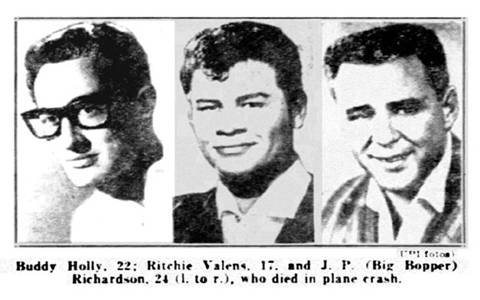
|
|
New York
Daily News, February 4,
1959
|
As memorable as the loss remains, the
incident had to compete for headline space.
In
East Germany
, an American convoy headed for
Berlin
was being detained at a Soviet checkpoint.
In
New York
, an airliner had crashed into the
East River
, killing 65 people.
Most of us had limited experience with mourning, and none with mourning
the loss of celebrities about whom we cared.
It did not feel good, but we would get more practice.
By June 1964, singers Johnny Horton, Eddie Cochran, and Patsy
Cline all would die in crashes.
Neatness
Counted
In the 1980s, when my son's teachers
said that children needed home computers to do well in school, I
laughed. I remembered my
parents getting a typewriter in the 1950s, after a teacher told them
that students like my next-older sister needed one to succeed in high
school. Before that, they
had been told that students like her older sister (who already was at the top of her high school
class) needed a good fountain pen to do well.
|
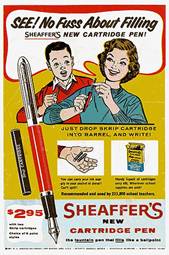
|

|
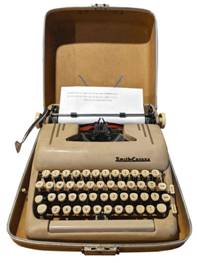
|
|
We
could buy these pens in school, with six ink cartridges, for
about $1.39.
fountainpennetwork.com
|
In
the 1950s, did your Mom or Dad spend 6 bucks apiece on ballpoint
pens for you?
parkerpens.net
|
A
Smith-Corona like my sister's; the color was called "Desert
Sand."
magazinesandbooks.com
|
In Junior High, our text books had to
be covered; for some reason, the bright shiny covers with the college
names and colors were popular. Decent
ballpoint pens were hard to find. The
early cheap click ballpoints skipped, smeared, and stopped writing with
plenty of ink remaining - unless they fell apart first.
The ones with clips marked
USA
were rumored to originate in
Usa
, supposedly an obscure place in
Japan
. Not true.
They were junk, but they were American-made junk.
Fortunately, Paper-Mates and Parker
Jotters came along.
Into
the 1960s with Enthusiasm
First the Soviets put dogs in
space (they didn't return). Then
we sent monkeys, and later a chimp, on round trips.
NASA's rockets and capsules seemed ready, but it took more than
a year to finalize the procedures for sending Alan Shepherd into space.
While he waited, Yuri Gagarin eventually went there and back.
A month later, we listened to radio coverage via the PA
system, as Shepherd took
America
's first space flight. Three
years later, when we graduated from HHS, Project
Mercury had run its course, and Project
Gemini test flights were in progress.
|

|
|
Unlike his non-human predecessors
in space, NASA's Ham actually
performed tasks, like moving
levers on command.
Wikipedia.org
|
President
Kennedy's ability to inspire made deep impressions.
He described space as The New Frontier, and he championed the Mercury, Gemini, and Apollo projects
that had been started in the 1950s during the Eisenhower Administration.
The
Physical Fitness movement arose because draftees and enlistees who
joined the American military were arriving in increasingly bad shape.
Ike's Council on Youth
Fitness had been unable to improve things, but Kennedy succeeded, in
part by re-purposing an old memo from Teddy Roosevelt.
TR had challenged Marines to go on 50-mile hikes; now, JFK used
the same wording to urge all Americans to go on them.
|
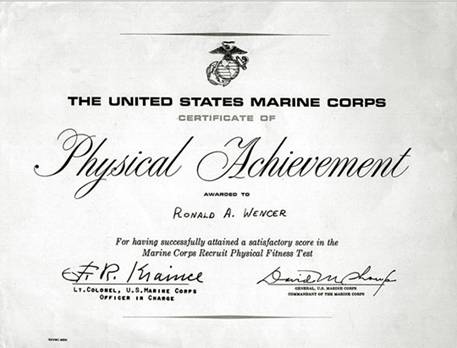
|
|
author's
collection
|
I,
for one, would have gladly hiked 50 miles back then instead of enduring
"Physical Fitness Mondays" in Phys Ed.
Each week, immediately following Lunch, I faced 50 minutes of
calisthenics, steadily working during the year up to 75 of these, 200 of
those, a ¼ mile lap on the track, etc.
Male students all endured these sessions, and many eventually
received Marine Corps fitness certificates.
News,
to Remember and Forget
As a nation, we continued to
achieve exciting things in space and in the gymnasium, but the world at
large remained troubling.
The Bay of Pigs debacle was
shameful. The Cuban Missile Crisis ended better, despite the brinkmanship.
It was, incidentally, not quite the victory that we thought at
the time: in exchange for the removal of USSR missiles from Cuba, we
removed our comparable Moscow-aimed missiles from Turkey.

|
|
East German border guard Hans Konrad Schumann, 19,
escapes to the West by leaping over barbed wire
iconicphotos.wordpress.com
|
The world watched as East
Germany built a wall across Berlin.
At least 140 people would later die trying to cross it, but
in the beginning, thousands made it to the West safely.
Viet Cong forces won
their first victory of many. Buddhist
monks died in flaming protest against the South Vietnamese Diem
government - a regime later toppled by its own military, its
leaders executed.
In domestic news, Martin Luther King led demonstrations for equal civil
rights, and then organized a March
on Washington. A Klan
church bombing killed four Alabama girls.
Prayer in public school was banned.
Timothy Leary was fired from Harvard because of unauthorized
experiments with psychedelic drugs.
The first liver transplant was performed.
Clark Gable and Marilyn Monroe died, as did Billie Holiday and
Dinah Washington.
Television Grew With Us
As the program line-up evolved,
anti-communist shows like I Led
Three Lives went the way of McCarthyism.
Westerns stampeded over much of the competition, as reality shows
have done in recent years. Popular
radio shows like Gunsmoke were
reborn for television, often with new, more visually-appealing actors in
lieu of the radio stars. Outlandish
sitcoms like I Love Lucy
yielded to more polished series, with real plots and some drama as well
as laughs, like the Dick Van Dyke
show. Phil Silvers, whose
burlesque manner had not worked on radio, thrived as Sgt. Bilko on You'll
Never Get Rich. Perhaps
the most curious sitcom was The
Many Loves of Dobie Gillis, which almost exclusively featured
teenagers as major characters. The
show relied on words and whimsy, not sets and scenery.
In case you've forgotten, the only movie theater in town always
played the same movie, The Monster
That Devoured Cleveland.
There were varieties of variety shows.
Dinah Shore's was mostly musical, Red Skelton's was mostly
comedic, and Ed Sullivan's was mostly... hard to categorize.
|

|
|
And he could wield a comb even
better than he could act!
stumptownblogger.com
|
Aimed squarely at us were the Warner
Brothers' crime-fighting series, like 77
Sunset Strip and Hawaiian Eye.
We joined our parents as they watched
Naked City, Peter Gunn, and Perry Mason.
Incidentally, Mason episodes included a wide range of actors, from silent-era
great Francis X. Bushman to a very
young Robert Redford, in his first-ever appearance on a screen.
Game shows with huge prizes held the
nation's attention, until news broke that some were fixed.
Panel shows, and Truth or Consequences (a transplant from radio), were watched
because people enjoyed seeing the game played; prizes didn't really
matter.
Theater had a strong presence on TV.
There were live dramas, even musicals like Kiss Me Kate or Peter Pan.
The latter featured the original Broadway cast (except for the
child actors, who had outgrown their roles).
Rod Serling's Twilight Zone showed us life from new and fantastic perspectives.
You Are There recreated historical events, from the death of
Socrates through the attack on Pearl Harbor.
|
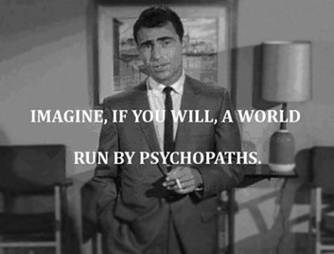
|
|
Sadly, we no longer have to imagine.
rebloggy.com
|
The television season was long, and
regular shows took the summer off. Instead
of reruns, we got "summer replacement" series, sometimes hosted by
stars like Bobby Darin. Quality
reruns only came along after the invention of videotape, which made its
on-air debut late in 1963, showing us the first instant replays during
the annual Army-Navy football game.
New technologies also made possible trans-oceanic broadcasts (the
first used Telstar I in 1962), and series in color (Bonanza was the first to use color from the start).
Alas, Dallas
We were seniors, and events suddenly
revealed that we were more innocent and vulnerable than we knew.
JFK's death seemed to indelibly stain our lives.
Looking back now across the years, trying to ignore all the later
theories, revelations, and hypotheses, can we still see the John F.
Kennedy whom we thought we knew?
As children of our times, we viewed the world through broadcast media.
After the countless pictures of aged leaders like Konrad Adenauer
and Charles De Gaulle, JFK seemed refreshing.
In hindsight, he reminds me of the era's Pepsi
slogan, which extolled those who
think young. In fact, he
was our parents' age, and he had always been fabulously wealthy.
We had no real reason to identify with him, but we did.
In 1959, my English teacher praised Kennedy's book Profiles in Courage, hoping to convince us that a successful
politician could still value principles.
Others of my teachers would also praise Senator-cum-President
Kennedy. When, in our
sophomore year, the school Variety Show was called The
New Frontier, the choice surprised no one.
Our generation was so smitten with JFK that we overlooked
something obvious: he had garnered only 50.17% of the popular vote; many
Americans were less impressed.
America later learned that, as with any other man, his substance and
image differed; there had been concealed nuances and imperfections.
Such flaws in no way excused his murder, or negated the ensuing
national suffering and grief.
|

|
|
Leaving Fort Worth for Dallas, November 22, 1963
jfklibrary.org
|
That afternoon, the news spread
quickly, stunning faculty and students alike.
Some wept.
In the coming days, media reconstructed our view of the world, so that
everything seemed to be happening in the context of the tragedy.
In this new world, old names and faces yielded to new ones.
Dan Rather, a local Dallas reporter, became a regular presence on
our screens. A touching
British television tribute introduced David Frost to us.
Lee Harvey Oswald was barely more than a name, until he became a
contorted face as he was murdered on live national television.
Jack Ruby, assassin of an assassin, took his place in the news.
|

|
|
John F. Kennedy Jr.
at his father's funeral
abc.net.au
|
The shock was relentless, and ever
deepening. To recapture the
feeling now is like chasing after an elusive dream.
Grief rolled over us like a rogue wave at Jones Beach.
There was no escape; we had to let it happen.
As had been true on "the day the music died," we would need
time to process and to heal, and healing would mean stretching something
within us, stretching it until we could believe that, even after all
this, the world was still OK.
Wrap-Up
We all have our own idiosyncratic memories of these years.
I, for one, am not overly-nostalgic.
I believe the times were not as good as they seemed - or
rather, I believe that they seemed good to us because, unlike our
parents, we did not have to spend them working at jobs, paying mortgages
and bills, fretting about inflation, perhaps quietly suffering
from PTSD, and raising
our children the best we could. Objectively,
this yesterday was no better than today.
We were the first generation raised with, and thus manipulated by,
telemedia. We believed too
readily in so many things. That
an actress's hair looked great because of the shampoo she endorsed.
That clean-cut, fair-haired people never lied.
That owning a car with tail fins showed people that you were
focused on the future.
Some among us may have been persuaded that one brand of cigarette made a
man more manly, or a woman more appealing.
Today, of course, we know that many of the public figures who
were paid to endorse cigarettes later succumbed to smoking-induced
cancers.
Indeed, as we've matured, we've learned new things, and we've had
to unlearn some old ones. Perhaps
some of our knee-jerk reactions to our feel-good memories are suspect,
but over all, those years gave us a good start in life, and they deserve
to be celebrated.
Ciao!
|




























